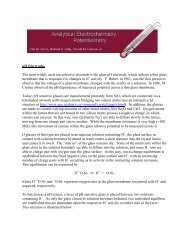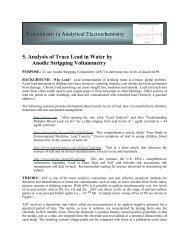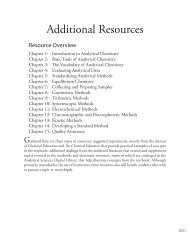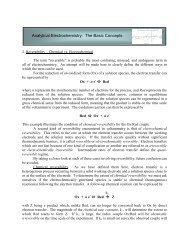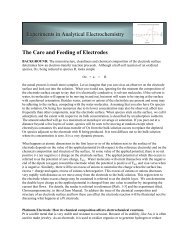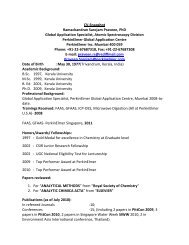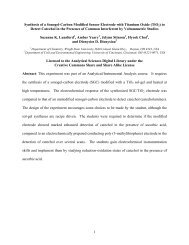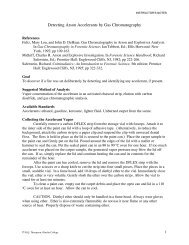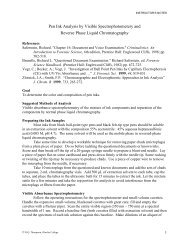- Page 1 and 2: GREEN CHEMISTRY Air Water Life Tech
- Page 3 and 4: GREEN CHEMISTRY AND THE TEN COMMAND
- Page 5 and 6: TABLE OF CONTENTS Chapter 1. Chemis
- Page 7 and 8: Chapter 6. Energy Relationships . .
- Page 9 and 10: 10.10. Soil and Plants Related to W
- Page 11 and 12: THE AUTHOR Stanley E. Manahan is Pr
- Page 13 and 14: PREFACE Green Chemistry and the Ten
- Page 15: military poisons, means of detectin
- Page 18 and 19: Green Chemistry, 2nd ed But there c
- Page 20 and 21: Green Chemistry, 2nd ed remaining l
- Page 24 and 25: Green Chemistry, 2nd ed 1.4. ENVIRO
- Page 26 and 27: 10 Green Chemistry, 2nd ed Green ch
- Page 28 and 29: 12 Green Chemistry, 2nd ed Subsitut
- Page 30 and 31: 14 Green Chemistry, 2nd ed work aro
- Page 32 and 33: 16 Green Chemistry, 2nd ed 1.10. BA
- Page 34 and 35: 18 Green Chemistry, 2nd ed All chem
- Page 36 and 37: 20 Green Chemistry, 2nd ed - Na Cl
- Page 38 and 39: 22 Green Chemistry, 2nd ed gives a
- Page 40 and 41: 24 Green Chemistry, 2nd ed QUESTION
- Page 42 and 43: 26 Green Chemistry, 2nd ed
- Page 44 and 45: 28 Green Chemistry, 2nd ed carbon,
- Page 46 and 47: 30 Green Chemistry, 2nd ed are not
- Page 48 and 49: 32 Green Chemistry, 2nd ed CH 4 + H
- Page 50 and 51: 34 Green Chemistry, 2nd ed atomic n
- Page 52 and 53: 36 Green Chemistry, 2nd ed Consider
- Page 54 and 55: 38 Green Chemistry, 2nd ed as a hea
- Page 56 and 57: 40 Green Chemistry, 2nd ed Nitrogen
- Page 58 and 59: 42 Green Chemistry, 2nd ed 2C 8 H 1
- Page 60 and 61: 44 Green Chemistry, 2nd ed N N N N
- Page 62 and 63: 46 Green Chemistry, 2nd ed life ele
- Page 64 and 65: 48 Green Chemistry, 2nd ed respect
- Page 66 and 67: 50 Green Chemistry, 2nd ed elements
- Page 68 and 69: 52 Green Chemistry, 2nd ed 15. Give
- Page 70 and 71: 54 Green Chemistry, 2nd ed 31. What
- Page 72 and 73:
56 Green Chemistry, 2nd ed atoms ar
- Page 74 and 75:
58 Green Chemistry, 2nd ed atoms as
- Page 76 and 77:
60 Green Chemistry, 2nd ed ionic ch
- Page 78 and 79:
62 Green Chemistry, 2nd ed In order
- Page 80 and 81:
64 Green Chemistry, 2nd ed 3.4. COV
- Page 82 and 83:
66 Green Chemistry, 2nd ed • Espe
- Page 84 and 85:
68 Green Chemistry, 2nd ed The pred
- Page 86 and 87:
70 Green Chemistry, 2nd ed In fact,
- Page 88 and 89:
72 Green Chemistry, 2nd ed sulfate,
- Page 90 and 91:
74 Green Chemistry, 2nd ed Exercise
- Page 92 and 93:
76 Green Chemistry, 2nd ed Bases A
- Page 94 and 95:
78 Green Chemistry, 2nd ed 16. What
- Page 96 and 97:
80 Green Chemistry, 2nd ed
- Page 98 and 99:
82 Green Chemistry, 2nd ed H atoms
- Page 100 and 101:
84 Green Chemistry, 2nd ed 3CH 4 +
- Page 102 and 103:
86 Green Chemistry, 2nd ed sulfuric
- Page 104 and 105:
88 Green Chemistry, 2nd ed synthesi
- Page 106 and 107:
90 Green Chemistry, 2nd ed CaCl 2 (
- Page 108 and 109:
92 Green Chemistry, 2nd ed in which
- Page 110 and 111:
94 Green Chemistry, 2nd ed Consider
- Page 112 and 113:
96 Green Chemistry, 2nd ed Note tha
- Page 114 and 115:
98 Green Chemistry, 2nd ed Percent
- Page 116 and 117:
100 Green Chemistry, 2nd ed M = mas
- Page 118 and 119:
102 Green Chemistry, 2nd ed Mass Ca
- Page 120 and 121:
104 Green Chemistry, 2nd ed CaCO 3
- Page 122 and 123:
106 Green Chemistry, 2nd ed bubbles
- Page 124 and 125:
108 Green Chemistry, 2nd ed not. Wh
- Page 126 and 127:
110 Green Chemistry, 2nd ed true of
- Page 128 and 129:
112 Green Chemistry, 2nd ed Alkanes
- Page 130 and 131:
114 Green Chemistry, 2nd ed carbon
- Page 132 and 133:
116 Green Chemistry, 2nd ed found i
- Page 134 and 135:
118 Green Chemistry, 2nd ed 5.4. FU
- Page 136 and 137:
120 Green Chemistry, 2nd ed H H C H
- Page 138 and 139:
122 Green Chemistry, 2nd ed chlorof
- Page 140 and 141:
124 Green Chemistry, 2nd ed n HO O
- Page 142 and 143:
126 Green Chemistry, 2nd ed O C C O
- Page 144 and 145:
128 Green Chemistry, 2nd ed This is
- Page 146 and 147:
130 Green Chemistry, 2nd ed as stea
- Page 148 and 149:
132 Green Chemistry, 2nd ed H O The
- Page 150 and 151:
134 Green Chemistry, 2nd ed 16. Wha
- Page 152 and 153:
136 Green Chemistry, 2nd ed is equa
- Page 154 and 155:
138 Green Chemistry, 2nd ed 4 0 4 1
- Page 156 and 157:
140 Green Chemistry, 2nd ed C 6 H 1
- Page 158 and 159:
142 Green Chemistry, 2nd ed 6.4. EN
- Page 160 and 161:
144 Green Chemistry, 2nd ed and wil
- Page 162 and 163:
146 Green Chemistry, 2nd ed a steam
- Page 164 and 165:
148 Green Chemistry, 2nd ed The imp
- Page 166 and 167:
150 Green Chemistry, 2nd ed But the
- Page 168 and 169:
152 Green Chemistry, 2nd ed Si As B
- Page 170 and 171:
154 Green Chemistry, 2nd ed primari
- Page 172 and 173:
156 Green Chemistry, 2nd ed There i
- Page 174 and 175:
158 Green Chemistry, 2nd ed Nuclear
- Page 176 and 177:
160 Green Chemistry, 2nd ed 36. Wha
- Page 178 and 179:
162 Green Chemistry, 2nd ed the two
- Page 180 and 181:
164 Green Chemistry, 2nd ed somewha
- Page 182 and 183:
166 Green Chemistry, 2nd ed CO 2 fr
- Page 184 and 185:
168 Green Chemistry, 2nd ed 2{CH 2
- Page 186 and 187:
170 Green Chemistry, 2nd ed 7.8. WH
- Page 188 and 189:
172 Green Chemistry, 2nd ed Gas exc
- Page 190 and 191:
174 Green Chemistry, 2nd ed in orch
- Page 192 and 193:
176 Green Chemistry, 2nd edts and a
- Page 194 and 195:
178 Green Chemistry, 2nd ed are ver
- Page 196 and 197:
180 Green Chemistry, 2nd ed insecti
- Page 198 and 199:
182 Green Chemistry, 2nd ed Plant-d
- Page 200 and 201:
184 Green Chemistry, 2nd ed and cap
- Page 202 and 203:
186 Green Chemistry, 2nd ed Water b
- Page 204 and 205:
188 Green Chemistry, 2nd ed stored.
- Page 206 and 207:
190 Green Chemistry, 2nd ed Wastewa
- Page 208 and 209:
192 Green Chemistry, 2nd ed 16. Wha
- Page 210 and 211:
194 Green Chemistry, 2nd ed
- Page 212 and 213:
196 Green Chemistry, 2nd ed the abs
- Page 214 and 215:
198 Green Chemistry, 2nd ed short t
- Page 216 and 217:
200 Green Chemistry, 2nd ed where h
- Page 218 and 219:
202 Green Chemistry, 2nd edproperti
- Page 220 and 221:
204 Green Chemistry, 2nd ed 8.4. AT
- Page 222 and 223:
206 Green Chemistry, 2nd ed evapora
- Page 224 and 225:
208 Green Chemistry, 2nd ed • Atm
- Page 226 and 227:
210 Green Chemistry, 2nd ed N 2 + O
- Page 228 and 229:
212 Green Chemistry, 2nd ed • Dir
- Page 230 and 231:
214 Green Chemistry, 2nd ed the pla
- Page 232 and 233:
216 Green Chemistry, 2nd ed meters.
- Page 234 and 235:
218 Green Chemistry, 2nd ed CH 4 +
- Page 236 and 237:
220 Green Chemistry, 2nd ed consump
- Page 238 and 239:
222 Green Chemistry, 2nd ed 25. Wha
- Page 240 and 241:
224 Green Chemistry, 2nd ed highly
- Page 242 and 243:
226 Green Chemistry, 2nd ed All org
- Page 244 and 245:
228 Green Chemistry, 2nd ed Eukaryo
- Page 246 and 247:
230 Green Chemistry, 2nd ed Enzyme
- Page 248 and 249:
232 Green Chemistry, 2nd ed Control
- Page 250 and 251:
234 Green Chemistry, 2nd ed tempera
- Page 252 and 253:
236 Green Chemistry, 2nd ed rock an
- Page 254 and 255:
238 Green Chemistry, 2nd ed is stil
- Page 256 and 257:
240 Green Chemistry, 2nd ed 9.8. GE
- Page 258 and 259:
242 Green Chemistry, 2nd ed whether
- Page 260 and 261:
244 Green Chemistry, 2nd ed The deg
- Page 262 and 263:
246 Green Chemistry, 2nd ed that is
- Page 264 and 265:
248 Green Chemistry, 2nd ed 20. One
- Page 266 and 267:
250 Green Chemistry, 2nd ed
- Page 268 and 269:
252 Green Chemistry, 2nd ed • The
- Page 270 and 271:
254 Green Chemistry, 2nd ed Earthqu
- Page 272 and 273:
256 Green Chemistry, 2nd ed Along w
- Page 274 and 275:
258 Green Chemistry, 2nd ed extreme
- Page 276 and 277:
260 Green Chemistry, 2nd ed using l
- Page 278 and 279:
262 Green Chemistry, 2nd ed Soil so
- Page 280 and 281:
264 Green Chemistry, 2nd ed as a re
- Page 282 and 283:
266 Green Chemistry, 2nd ed Natural
- Page 284 and 285:
268 Green Chemistry, 2nd ed 10.10.
- Page 286 and 287:
270 Green Chemistry, 2nd ed capacit
- Page 288 and 289:
272 Green Chemistry, 2nd ed Among t
- Page 290 and 291:
274 Green Chemistry, 2nd ed includi
- Page 292 and 293:
276 Green Chemistry, 2nd ed Future
- Page 294 and 295:
278 Green Chemistry, 2nd ed 9. What
- Page 296 and 297:
280 Green Chemistry, 2nd ed the cas
- Page 298 and 299:
282 Green Chemistry, 2nd ed Materia
- Page 300 and 301:
284 Green Chemistry, 2nd ed 11.3. L
- Page 302 and 303:
286 Green Chemistry, 2nd ed 11.4. K
- Page 304 and 305:
288 Green Chemistry, 2nd ed The Exx
- Page 306 and 307:
290 Green Chemistry, 2nd ed between
- Page 308 and 309:
292 Green Chemistry, 2nd ed water s
- Page 310 and 311:
294 Green Chemistry, 2nd ed process
- Page 312 and 313:
296 Green Chemistry, 2nd ed 4C 3 H
- Page 314 and 315:
298 Green Chemistry, 2nd ed H H H O
- Page 316 and 317:
300 Green Chemistry, 2nd ed synthes
- Page 318 and 319:
302 Green Chemistry, 2nd ed a react
- Page 320 and 321:
304 Green Chemistry, 2nd ed QUESTIO
- Page 322 and 323:
306 Green Chemistry, 2nd ed refinin
- Page 324 and 325:
308 Green Chemistry, 2nd ed 1. Carb
- Page 326 and 327:
310 Green Chemistry, 2nd ed increas
- Page 328 and 329:
312 Green Chemistry, 2nd ed photosy
- Page 330 and 331:
314 Green Chemistry, 2nd ed Through
- Page 332 and 333:
316 Green Chemistry, 2nd ed residue
- Page 334 and 335:
318 Green Chemistry, 2nd ed H H O H
- Page 336 and 337:
320 Green Chemistry, 2nd ed melt wh
- Page 338 and 339:
322 Green Chemistry, 2nd ed out the
- Page 340 and 341:
324 Green Chemistry, 2nd ed 11. Wha
- Page 342 and 343:
326 Green Chemistry, 2nd ed
- Page 344 and 345:
328 Green Chemistry, 2nd ed large a
- Page 346 and 347:
330 Green Chemistry, 2nd ed (RDX),
- Page 348 and 349:
332 Green Chemistry, 2nd ed Table _
- Page 350 and 351:
334 Green Chemistry, 2nd ed make th
- Page 352 and 353:
336 Green Chemistry, 2nd ed in the
- Page 354 and 355:
338 Green Chemistry, 2nd ed Cl H C
- Page 356 and 357:
340 Green Chemistry, 2nd ed in Wash
- Page 358 and 359:
342 Green Chemistry, 2nd ed behavio
- Page 360 and 361:
344 Green Chemistry, 2nd ed can be
- Page 362 and 363:
346 Green Chemistry, 2nd ed 7. Comp
- Page 364 and 365:
348 Green Chemistry, 2nd ed supplie
- Page 366 and 367:
350 Green Chemistry, 2nd ed utility
- Page 368 and 369:
352 Green Chemistry, 2nd ed The ach
- Page 370 and 371:
354 Green Chemistry, 2nd ed would b
- Page 372 and 373:
356 Green Chemistry, 2nd ed • Con
- Page 374 and 375:
358 Green Chemistry, 2nd ed safety
- Page 376 and 377:
360 Green Chemistry, 2nd ed 14.7. T
- Page 378 and 379:
362 Green Chemistry, 2nd ed 14.9. T
- Page 380 and 381:
364 Green Chemistry, 2nd ed A parti
- Page 382 and 383:
366 Green Chemistry, 2nd ed
- Page 384 and 385:
368 Green Chemistry, 2nd ed Bases 7
- Page 386 and 387:
370 Green Chemistry, 2nd ed Dissolv
- Page 388 and 389:
372 Green Chemistry, 2nd ed Hydroxy
- Page 390 and 391:
374 Green Chemistry, 2nd ed Particu
- Page 392 and 393:
376 Green Chemistry, 2nd ed Sustain
- Page 395:
1 2 3 4 5 6 7 IA 1 IIA 1 H 1.008 3



